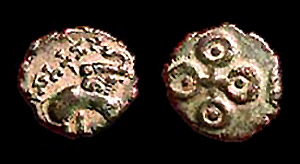 Satavahana coins have been discovered in scores of sites from Awra in central India down to Kanchipuram, Cuddalore and very recently Karur and Madurai in Tamil Nadu. The largest number of finds comes from the coastal districts of Andhra Pradesh. The Satavahana kings who ruled over large parts of South India from the 3rd century B.C. to the 3rd century A.D. issued huge quantities of coins in various metals in different sizes and shapes from different mints.
Satavahana coins have been discovered in scores of sites from Awra in central India down to Kanchipuram, Cuddalore and very recently Karur and Madurai in Tamil Nadu. The largest number of finds comes from the coastal districts of Andhra Pradesh. The Satavahana kings who ruled over large parts of South India from the 3rd century B.C. to the 3rd century A.D. issued huge quantities of coins in various metals in different sizes and shapes from different mints.
The Satavahanas produced coins in lead, copper, potin, brass, bronze and silver. The earliest and the majority of the Satavahana coins are made of lead. As regards the technique of manufacture of these coins, there are cast, die-struck and punch-marked coins among the Satavahana issues. Their coins display an extremely wide variety of symbols and devices in different combinations.
The Satavahanas also produced coins and some copper coins. They countermarked these coins by die-striking symbols such as the three-peaked hill and the Ujjain symbol on them. Such coins have been found at Jogalthambi in Maharashtra and Goa and few other places.
The Satavahana coins display devices such as the hill, river, tree, Goddess Lakshmi, lion, tiger, elephant, bull, horse, camel, wheel, Ujjain symbol and ship. Some coins even feature the royal bust. A few Satavahana coins bear legends or inscriptions in the Prakrit language and Brahmi script. These legends convey the name of ruler.






































